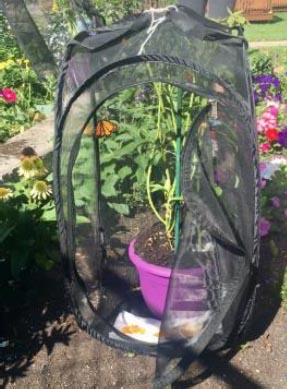Did you see any Monarch butterflies fluttering around this summer? If you did, there is a chance they were born and raised right here in St. Vital by the caring, nurturing, and very excited, seniors, youth volunteers and staff or Riverside Lions Seniors Residences.
As one part of our larger commitment to help support, protect and sustain a healthy local and global environment, staff and seniors of Riverside Lions are raising awareness Monarch butterflies, including the risks and needs they are currently encountering. Over the course of several months, we introduced Monarch butterflies into our community at various stage of life and development, watching them grow and evolve through various changes of life, from caterpillars through to becoming full adult butterflies. At the same time we developed various areas on our grounds to feed and support butterflies, planting many common feeding plants around our property and constructing a specific large butterfly garden area.

Riverside Lions would like to extend a special thank you to our special events organizer, Samantha Quiring and entomologist Taz Stuart from Poulins Pest Control for voluntarily helping our staff to properly and successfully prepare and required habitat and care of the butterflies we were entrusted with.
According to the World Wildlife, “The monarch butterfly goes through four stages in its life cycle: egg, caterpillar (larva), pupa (chrysalis) and butterfly. Once the eggs are laid, the species grows inside the egg for about four days. It then hatches into a caterpillar and feeds on the milkweed plant for about two weeks. The pupa lasts for about ten days and then hatches into a beautiful adult butterfly, whose lives for about 4-6 weeks, unless it is the late summer generation, which lives 6-7 months overwintering in Mexico.

Monarch butterflies are currently facing three major risks: illegal logging, lack of milkweed plants and climate change. WWF’s 2013-14 report from Mexico showed that the number of monarch butterflies wintering there was at its lowest in 20 years. This finding was determined by measuring the amount of forest they occupy; in 2013, the number of butterfly acres decreased to 1.65 acres compared to 27.5 acres in 2003.
Monarchs need mountain forests in Mexico for their winter habitat, however nearby human communities also rely on them and create pressure on forests through agriculture and tourism activities. In Canada and the U.S., monarchs need places to reproduce and feed. Herbicide use is also decreasing the availability of their primary food source, the milkweed plant.
Climate change threatens to disrupt the monarch’s annual migration pattern by affecting weather conditions both in wintering and summer breeding grounds.
For more information on Monarch Butterflies, their lifecycle, preferred habitats, migration and risks, please click here.
